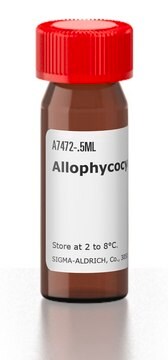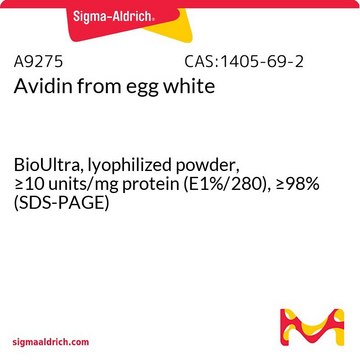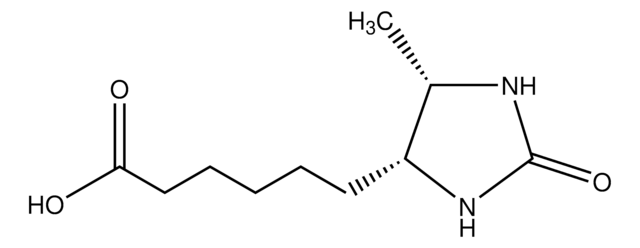B4501
Biotina
≥99% (HPLC), lyophilized powder
Sinónimos:
D-Biotina, Bios II, Coenzima R, Vitamina H, Vitaminas B7
About This Item
Productos recomendados
origen biológico
synthetic (organic)
Nivel de calidad
Ensayo
≥99% (HPLC)
Formulario
lyophilized powder
técnicas
HPLC: suitable
color
white to off-white
mp
231-233 °C (lit.)
solubilidad
ammonium hydroxide: 50 mg/mL (2 M)
temp. de almacenamiento
2-8°C
cadena SMILES
[H][C@]12CS[C@@H](CCCCC(O)=O)[C@@]1([H])NC(=O)N2
InChI
1S/C10H16N2O3S/c13-8(14)4-2-1-3-7-9-6(5-16-7)11-10(15)12-9/h6-7,9H,1-5H2,(H,13,14)(H2,11,12,15)/t6-,7-,9-/m0/s1
Clave InChI
YBJHBAHKTGYVGT-ZKWXMUAHSA-N
¿Está buscando productos similares? Visita Guía de comparación de productos
Descripción general
Aplicación
- for culturing of oligodendrocytes.
- as a vitamin supplement for the growth of Bacillus species.
- for blocking endogenous biotin during immunohistology procedures.
Acciones bioquímicas o fisiológicas
Otras notas
Aplicación
Producto relacionado
producto comparable
Código de clase de almacenamiento
11 - Combustible Solids
Clase de riesgo para el agua (WGK)
WGK 1
Punto de inflamabilidad (°F)
Not applicable
Punto de inflamabilidad (°C)
Not applicable
Equipo de protección personal
Eyeshields, Gloves, type N95 (US)
Elija entre una de las versiones más recientes:
Certificados de análisis (COA)
¿No ve la versión correcta?
Si necesita una versión concreta, puede buscar un certificado específico por el número de lote.
¿Ya tiene este producto?
Encuentre la documentación para los productos que ha comprado recientemente en la Biblioteca de documentos.
Los clientes también vieron
Nuestro equipo de científicos tiene experiencia en todas las áreas de investigación: Ciencias de la vida, Ciencia de los materiales, Síntesis química, Cromatografía, Analítica y muchas otras.
Póngase en contacto con el Servicio técnico







